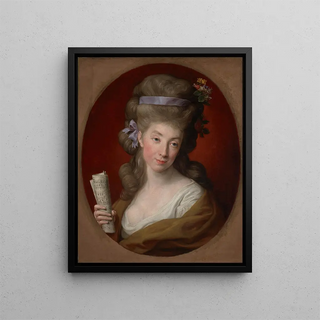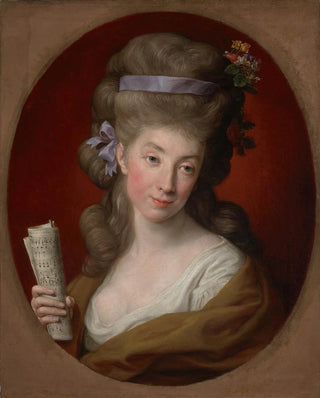Art print | Portrait of Izabela née Lubomirska, wife of Ignacy Potocki 1755-1783 - Pompeo Batoni


View from behind

Frame (optional)
Portrait of Izabela née Lubomirska, wife of Ignacy Potocki 1755-1783 - Pompeo Batoni – Captivating Introduction
The "Portrait of Izabela née Lubomirska, wife of Ignacy Potocki" by Pompeo Batoni is an iconic 18th-century work that embodies both aristocratic elegance and the finesse of classical portraiture. Created between 1755 and 1783, this painting depicts an undeniably charming woman, whose enigmatic gaze and graceful posture instantly captivate the viewer. Through this artwork, Batoni does more than portray a noble figure; he also immortalizes a moment in social and cultural history, where the art of portraiture becomes a means of asserting the status and beauty of the elite. The art print of this piece allows appreciation of the richness of its details and the depth of its colors, offering privileged access to the timeless beauty of Baroque art.
Style and uniqueness of the work
Batoni's style is characterized by an exceptional mastery of chiaroscuro and meticulous attention to detail, which are evident in the portrait of Izabela. The drapery of her dress, subtly rendered, seems almost tangible, while the reflections of light on her skin create an illusion of life. The composition, focused on the face and silhouette of the woman, highlights her delicacy and confidence. The color palette chosen by the artist, blending soft tones with more vivid shades, enhances Izabela's natural beauty while giving her an aura of nobility. Every element of this work, from the delicately nuanced background to the carefully selected accessories, contributes to creating an intimate and refined atmosphere where art and aristocratic life intersect.
The artist and his influence
Pompeo Batoni, born in Lucca in 1708, is one of the most influential portraitists of his time. His career was marked by travels to Rome, where he mingled with European elites seeking social recognition through art. Batoni distinguished himself by his ability to blend traditional Italian influences with elements of the Rococo style, thus offering a unique vision of portraiture

Matte finish

View from behind

Frame (optional)
Portrait of Izabela née Lubomirska, wife of Ignacy Potocki 1755-1783 - Pompeo Batoni – Captivating Introduction
The "Portrait of Izabela née Lubomirska, wife of Ignacy Potocki" by Pompeo Batoni is an iconic 18th-century work that embodies both aristocratic elegance and the finesse of classical portraiture. Created between 1755 and 1783, this painting depicts an undeniably charming woman, whose enigmatic gaze and graceful posture instantly captivate the viewer. Through this artwork, Batoni does more than portray a noble figure; he also immortalizes a moment in social and cultural history, where the art of portraiture becomes a means of asserting the status and beauty of the elite. The art print of this piece allows appreciation of the richness of its details and the depth of its colors, offering privileged access to the timeless beauty of Baroque art.
Style and uniqueness of the work
Batoni's style is characterized by an exceptional mastery of chiaroscuro and meticulous attention to detail, which are evident in the portrait of Izabela. The drapery of her dress, subtly rendered, seems almost tangible, while the reflections of light on her skin create an illusion of life. The composition, focused on the face and silhouette of the woman, highlights her delicacy and confidence. The color palette chosen by the artist, blending soft tones with more vivid shades, enhances Izabela's natural beauty while giving her an aura of nobility. Every element of this work, from the delicately nuanced background to the carefully selected accessories, contributes to creating an intimate and refined atmosphere where art and aristocratic life intersect.
The artist and his influence
Pompeo Batoni, born in Lucca in 1708, is one of the most influential portraitists of his time. His career was marked by travels to Rome, where he mingled with European elites seeking social recognition through art. Batoni distinguished himself by his ability to blend traditional Italian influences with elements of the Rococo style, thus offering a unique vision of portraiture






